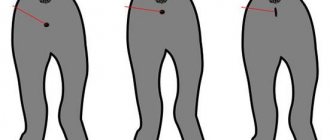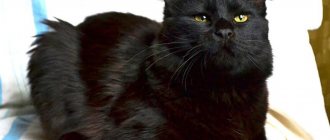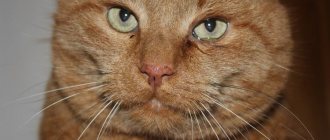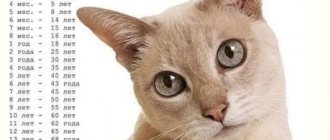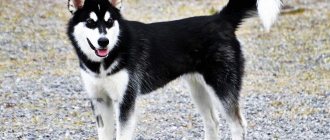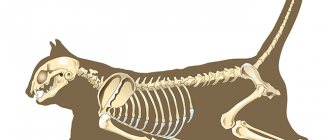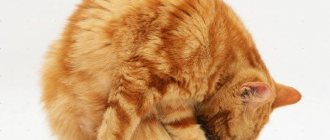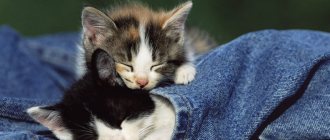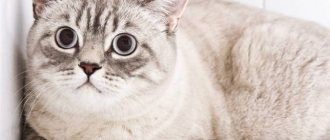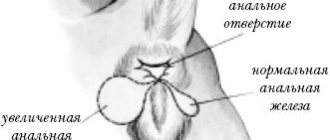The vast majority of people believe that our smaller brothers, namely cats, do not know how to express their feelings and moods. But this is not true at all. Cats' body language is very simple. The emotions of cats are very understandable and accessible to everyone.
To do this, you just have to watch carefully, and you will learn to distinguish, how to understand the cat's language. It is expressed primarily in the way the cat shakes its tail. But let's take a closer look at how and why cats shake their tail.
Narrow pupils
If your pet's pupils suddenly and sharply constrict, this is a sign of extreme arousal. It can be caused by many reasons. You can understand the one that currently caused the effect by “additional indicators”, such as the position of the tail, ears, and body.
- Most often, constricted pupils show emotions such as anger and anger. The animal is in a bad mood. At the same time, the ears are tense and turned back. The mustache, on the contrary, is directed forward. The muscles are tense, the fur is raised. Often, the cat makes threatening sounds;
- but this is not the only reason. Constriction of the pupils can be caused, for example, by the smell of your favorite food or the appearance of another feline in the house;
- if the pupils are narrow, but the animal slightly closes its eyelids, purrs blissfully and lies calmly on your lap, it is blissful;
- Of course, we cannot fail to mention that bright light always leads to constriction of the pupils, and not only in cats.
How to determine your pet's mood by its tail
The communicative function is one of the main ones for the tail. By waving it, the animal can demonstrate a whole range of emotions, from hatred to all-consuming love. Everything matters: the direction of movements, their amplitude and speed.
What does the position of a cat's tail indicate?
A complete dictionary of the “tailed” language could look like this:
Intense look
The cat may stare at you with wide eyes. And there may also be several reasons for this. Most often, in this way the animal asks to pay attention to it. It is hungry, wants affection, and feels bad. Or he wants to go to the toilet, but the tray is left behind the closed door.
With the help of a gaze, a cat can show its love. At the same time, she slowly closes her eyes. But an unfamiliar cat thus shows completely opposite emotions. She is trying to find out “who is boss” and the person, if he does not look away in time, may be attacked by an animal.
Also, the reason for a frozen gaze may be preparation for aggression. At the same time, the animal is tense, makes threatening sounds, and the tail moves from side to side.
And the most unusual reason for such a look may be the truly human pleasure we receive when, while relaxing, we look at how another person works. This is also sometimes characteristic of cats.
How else can a cat “talk”?
The tail is not the only way a cat can show its attitude. Animals have quite a lot of visual aids: ears, paws, and the whole body. Quite often they convey information using sound signals.
Interesting!
Tailless cat breeds are becoming increasingly popular. Now there are several dozen of them. Some are already recognized as felinologists, others are just winning their hearts. The owners of such pets claim that the absence of a fifth limb does not interfere with their mutual understanding.
The human-cat dictionary can be supplemented with the following sections.
Communication using the body
Cat conversations can involve the whole body. With the help of movements, the animal is able to convey all important information and clarify details “left unsaid” by the tail.
| Gesture | Image | Designation |
| “I’m interested”, “I’m listening to you” | ||
| “I am completely happy, calm and content” | ||
| “There’s danger somewhere nearby, but I’m on my guard.” | ||
| “I acknowledge your superiority”, “I’m bored” | ||
| “I love you”, “I want to please you” | ||
| “You are only mine”, “Stroke me” | ||
| “I trust you completely”, “I love you” | ||
| “I need your attention”, “Stroke me” | ||
| “I feel danger, but I want to avoid a fight”; “Let’s resolve everything peacefully or I can’t vouch for myself” | ||
| "I will fight" |
Communication using glances
Eyes also play a huge role in dialogue. By studying the cat's language of views, you can not only learn to understand your pet, but also respond to him in such a way that he understands.
Dilated pupils
Most often, cats dilate their pupils when there is any danger. The ears are turned out and pressed down, the whiskers are directed back. Hissing and display of claws are often added.
The pupils dilate to the owner's call, while the ears extend in the direction of the sound. It is typical that the cat may not even turn towards the person, pretending that he does not hear him.
If the animal's eyes are wide open and its ears are alert, then it is most likely in a playful mood and the best way out would be to just play with it. And, naturally, cats' pupils dilate significantly in the dark.
To more accurately decipher a cat’s gaze, it is necessary to involve “witnesses”, such as ears, whiskers, body position, and sounds made by the animal. The most informative is the position and behavior of the tail. All this together will allow you to master the cat's language and always be aware of the emotional state of your pet.
Cat tail device
The tail of animals is an extension of their spine.
According to the anatomical description, it consists of three parts - base, stem and tip. The average length of a cat's tail is 25 cm, for cats this figure is approximately 28 cm, however, in the Guinness Book of Records there is a mention of the longest-tailed domestic cat - its length of this part of the body is neither more nor less, but as much as 41.5 cm. It may include a different number of vertebrae, depending on the length - from 19 to 28. They are oval in shape, connected by cartilage tissue and braided with muscles. In the middle of the vertebrae there are openings through which the spinal canal passes. The tip of the tail includes from 5 to 7 vertebrae, the last of which is not always fully developed or is pointed.
Thanks to the thickened intervertebral cartilages, the tail has a certain flexibility. Each cavity between the vertebrae has a plexus of nerve endings. You don't have to be a veterinarian to know that a cat's tail is an extremely sensitive part of the body.
How to tell how a cat is feeling by its tail
The movements of a cat's tail can serve as an indicator of health. Having fallen ill, the animal will begin to make movements that were previously unusual for it. This is a sign that you need to take a closer look at your pet’s behavior and, if you notice other warning signs, contact your veterinarian.
You can tell how your cat is feeling by the movement of his tail.
Attention! Sharp twitching of the tail can be a signal that the animal has reached puberty and is experiencing excitement. If a pet shakes its tail when near a wall or piece of furniture, it means it is marking its territory.
The following table will help you understand what is happening in your pet’s body.
| Disease | Tail movement | Other signs | Image |
| Rabies | Sharp convulsive twitching of the tail and back | Refusal of water while maintaining appetite, excessive salivation, aggression or attempts to hide | |
| Neurosis | Chaotic twitching of the tail and whole body | Excessive licking, leading to deterioration in coat quality | |
| Parasite infestation | Sudden twitching of the tail and back of the back | Frequent scratching, sudden movements, attempts to catch fleas with teeth | |
| Oncological diseases | Frequent, chaotic movements of the tail | Lethargy, lack of appetite | |
| Tail injuries | Tail tucked | Lethargy, irritability, lack of appetite |
For all its simplicity, a cat's tail is capable of performing a wide variety of tasks. With its help, a pet can not only talk about its feelings, but also hint at its well-being. Therefore, it is so important for every responsible owner to know this special language.
Needs for development of intelligence
Don't be afraid of pets chasing their tails. Cats are allowed to hunt for parts of their body at a young age. If the game lasts for a long time, you should ask a specialist about possible developmental disorders.
To develop your pet's intelligence, you can invite him to play special games. They will help the animal acquire the skills necessary for hunting. Toys can help your pet.
Types of toys popular among cats:
- feathers attached to a holder;
- bells on a cord;
- beanbag;
- a toy filled with catnip;
- interactive games on a tablet.
shutterstock
If games do not help and the animal continues to run in circles after its tail, you should think about a mental disorder.
Functions provided by nature
Unlike human tail vertebrae, which have become useless vestiges, felines still perform all the functions that nature intended for them. These include:
- balancing;
- communication;
- status indicator;
- temperature adjustment.
Let's look at each of these functions in more detail, not forgetting to mention one more - entertainment. She will explain to you what the tail is for a recently lambed cat and why adult animals experience increased stress when meeting hyperactive kittens.
Perfect balance
When telling why a cat has a tail, it’s worth starting with the function of the steering wheel. With its help, the animal skillfully avoids skidding, climbs trees, makes jumps, stays on a narrow ledge and even navigates in the dark.
When falling from a great height, the tail begins to rotate and twitch intensively, helping the body to take a safe position for it. This is why mustachioed pets often land on 4 paws without getting hurt or hurt.
Communication method
Most owners don’t even hesitate when answering why a cat has a tail. Every day they are faced with the fact that mustachioed pets shake or wag their fluffy fan while communicating.
Unlike humans, the main way animals communicate is non-verbal. They use sign language to interact with other four-legged animals and their owners. Thanks to the movement of the tail, you can understand not only the desires of your pet, but also its mood.
Emotion screen
The range of emotions conveyed by a cat's tail is very wide. The most common ones can be found in the table below.
| Emotion | Ponytail position | Other signs |
| Anxiety |
|
|
| Playfulness |
| |
| Calm |
|
|
| Malice |
|
|
| Happiness |
|
|
| Pain |
|
|
| Fear |
|
|
With each subsequent function, it becomes more and more clear why cats have tails. But its capabilities are not limited to coordination and communication. The comparison with the fan was given for a reason, because another useful function of the tail is thermoregulation.
To have something to brush off
The fluffy fan cools the body very well in hot weather. But that’s not all a cat needs a tail for. By wrapping it around its nose, muzzle and paws, the mustachioed pet successfully warms up frozen parts of the body. This feature allows you to create the desired microclimate in any weather conditions.
The tail can be a toy!
Small predators do not try to understand why a cat has a tail - they simply attack it, mistaking it for a potential prey. For this reason, adult animals often suffer from restless kittens who want to play with their wealth.
Grown-up cats rarely chase someone else's or their own tail. If they are nevertheless noticed doing this strange thing, they quickly lose interest in it.
Physical problems
Veterinarians focus on the health status of the pet if its behavior is a symptom of disease. The reason for chasing your own tail can be pain, itching, burning caused by:
- parasitic diseases – worms, fleas, ticks;
- inflammation of the paraanal glands;
- anal herbs;
- constipation;
- skin diseases;
- allergies to food;
- tail injuries - fracture, bites of other animals, compression, torn ligaments;
- mental disorders, for example, the consequences of brain injuries and infections.
It is necessary to pay attention to such behavior in a timely manner. Also watch the video why a cat chases its tail:
Also watch the video why a cat chases its tail:
Signs of a Sad Cat
Your cat may show subtle signs of stress, making it difficult to notice any changes in behavior. To determine if your cat is unwell, check for these possible signs of depression:
Low energy level
Cats usually sleep a lot. A depressed cat will sleep even more. If you notice a sudden change in your cat's sleep pattern, it means she may be unhappy.
Unusually low energy levels are a red flag for an unhappy cat, suggesting mental or physical problems.
Changes in care
Depressed cats usually stop grooming themselves, leaving themselves unkempt.
Pain
Pain is one of the most underdiagnosed conditions in cats, especially in older adults. This is one of the main clinical signs of depression.
Changes in appetite
If your cat changes its usual eating behavior, it could be a sign of depression. Sad cats may lose interest in their regular diet.
Changing your daily routine
A cat that suddenly changes its behavior may be stressed. Have they stopped using the litter box? Do they leave their usual sleeping area? A sad cat may lose interest in the activity that initially made him happy.
Aggression
A sad cat becomes more aggressive. Examples of aggressive behavior in cats include hissing, biting, chasing, and growling. If you notice this behavior, it may be time to visit your veterinarian.
Functions of a cat's whiskers
Why does a cat need a mustache? They are endowed with certain functions. It is worth considering in more detail those of them that are basic.
First class hunter
In ancient times, it was believed that the length of a cat's whiskers determined how good a hunter he would be. And they were right to some extent. The whiskers function as a locator, picking up even the smallest signs of activity, accurately determining where the victim is.
Air currents coming from a moving object come into contact with the whiskers, irritating them. It should also be noted that four-legged pets use their whiskers to evaluate the taste of food.
Location orientation
Why does a cat need a mustache? Surely, many were surprised by the ability of pets to move in complete darkness. And in this they are helped not only by excellent vision, but also by the functioning of their mustache. With their help, cats “feel” the surrounding space, finding obstacles in their path. So we can say that the mustache is a navigator present in the pet’s body.
Sociable pet
While watching your four-legged friend, look at the position of the whiskers when he is interested in events or a person. Usually, they immediately move forward. You should learn to recognize what your fluffy is telling you. If he presses his antennae to his muzzle, he experiences irritation and a bad mood. Fluffy and splayed - the pet is in a great mood.
Why do cats wag their tails?
The cat waves its tail differently, the movements reflect a certain emotion, positive or negative. The cat shakes its tail with a certain intensity, proportional to the strength of the emotions experienced.
Kittens often catch and bite their own tail, which acts as a toy and helps them acquire hunting skills.
Since a cat has an individual character and behavior, tail movements may not mean what is commonly believed. Therefore, it is recommended to determine cat emotions from your own experience, focusing on the information presented.
Positive reasons
There are many positive reasons why cats noticeably wag their tails:
- are in a playful mood and invite you to play;
- express love for the owner and household members (the vertically raised tip trembles);
- show interest, curiosity (slight twitching);
- they feel happiness, satisfaction, express complete calm (they move only the tip of their tail);
- express friendliness and trust (the caudal vertebrae are parallel to the floor);
- experience the excitement of the hunt, observe a potential victim - a mouse, a fly, a bow on a rope;
- are thoughtful (broad, relaxed movements);
- feel satisfied, want to communicate (the caudal process is lowered, relaxed);
- feel superiority and security, are confirmed in leadership (hold the organ like a “pipe”);
- thank the owner for his care and affection (the cat slowly and smoothly waves its tail).
What does it mean when a cat wags its tail?
Everyone knows that the tail
- This is not only a decoration for a cat. It helps to successfully land on the ground or floor when jumping from a height, to balance fearlessly on fences and tree branches, coordinating the balance of the animal. And the tail of mustachioed pets is a real mood indicator. Unable to express their emotions through words, our smaller brothers use body language. And, perhaps, the movements of a cat’s tail can demonstrate to the owner what the animal is experiencing, more eloquently than any meow.
Why you shouldn't pull your pet's tail
The cat should not be pulled by the thin tail vertebrae. According to popular belief, the pet will begin to defecate in the wrong corners. In reality, these actions are cruel, physically unpleasant for the animal, cause discomfort, and often cause injury and illness.
A bully, grabbing a cat wagging its tail, can injure the vertebrae, requiring surgical assistance or amputation.
Often hooligan actions lead to paralysis of the hind limbs and urinary incontinence in the pet.
Cats are vengeful, tugging and squeezing - which means humiliation of dignity - does not forgive, they begin to take revenge.
